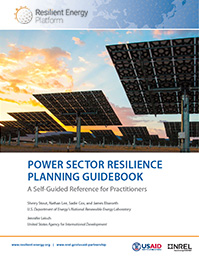Guidebook
Planning for Power Sector Resilience
The provision of reliable, secure, and affordable electricity is essential to power economic growth and development. The power system is at risk from an array of natural, human-caused, and technological threats, which can cause everything from power interruption to chronic undersupply of energy. It is critical for policymakers, planners, and system operators to safeguard their power systems from these threats by proactively planning for future needs and investing in resilient power systems.
Use of this Guidebook
As a manual for power sector resilience planning, this guidebook can be used by policymakers, power sector investors, planners, system operators, and other energy-sector stakeholders as a stand-alone resource or shared with participants at stakeholder workshops to facilitate discussions and complete key steps of a power sector resilience planning process.
The guidebook is organized into chapters that guide readers through the resilience planning process as shown below. Each chapter focuses on a specific topic and presents the basic concepts, a brief planning guide, and activities to support planning. These resources facilitate the step-by-step power sector resilience planning process and enables readers to:
-

Identify Threats
Identify the potential threats to the power sector and score the likelihood of occurring.
-

Define Impacts
Define the potential impacts on the power sector that may result from these threats.
-

Assess Vulnerabilities
Assess the vulnerabilities of the power sector and score their potential severity.
-

Calculate Risks
Calculate the risks resulting from linked threats and vulnerabilities in a risk matrix.
-

Develop Solutions
Develop and prioritize resilience action plans based on impact, ability to implement, and cost..








